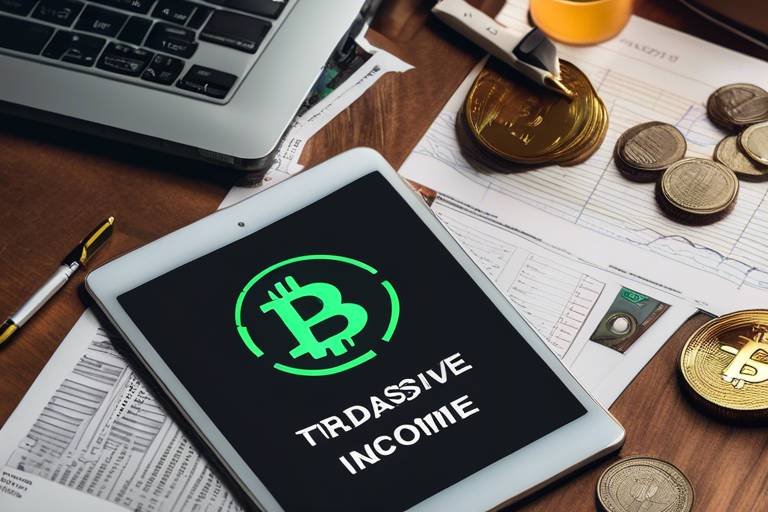Strategies for Trading Cryptocurrencies with High Volatility
Welcome to the thrilling world of cryptocurrency trading, where the only constant is change! If you've ever dipped your toes into this market, you know that high volatility can feel like riding a roller coaster—exciting yet terrifying. But don’t worry! With the right strategies, you can navigate these wild price swings and potentially come out on top. In this article, we’ll explore various techniques that can help you maximize profits while minimizing risks in this unpredictable arena.
First and foremost, let’s talk about what we mean by high volatility. In the crypto world, prices can skyrocket one moment and plummet the next, often within a matter of hours or even minutes! This unpredictability is driven by several factors, including market sentiment, regulatory news, and technological advancements. Understanding these elements is crucial for any trader looking to capitalize on price movements. Are you ready to dive in and learn how to harness this volatility to your advantage?
One of the most effective ways to trade cryptocurrencies with high volatility is through risk management. Think of it as your safety net. Without it, a single bad trade could wipe out your entire investment. Techniques such as stop-loss orders, position sizing, and diversification are your best friends in this journey. They provide you with a framework to safeguard your assets while allowing you to take calculated risks. So, let’s break down these strategies step by step!
Cryptocurrency volatility refers to the rapid price fluctuations that can occur within short timeframes. This section delves into the factors contributing to volatility and its implications for traders.
Effective risk management is crucial when trading volatile cryptocurrencies. Here, we discuss various techniques such as stop-loss orders, position sizing, and diversification to protect your investments.
Stop-loss orders help traders limit their losses by automatically selling assets at predetermined prices. This subheading explains how to effectively set stop-loss levels to manage risk.
Choosing the right stop-loss level requires analysis of market conditions and personal risk tolerance. This section offers tips for determining optimal stop-loss placements.
As market conditions change, adjusting stop-loss orders can help secure profits or minimize losses. This part discusses strategies for modifying stop-loss levels based on market trends.
Position sizing is critical for managing risk in volatile markets. This subheading outlines methods for calculating appropriate position sizes based on account balance and risk tolerance.
Technical analysis involves using historical price data to forecast future movements. This section covers key indicators and chart patterns that can aid in trading volatile cryptocurrencies.
Certain technical indicators can provide insights into market trends and potential reversals. This part highlights essential indicators like RSI, MACD, and Bollinger Bands for volatile trading.
Recognizing chart patterns can help traders anticipate price movements. This section discusses common patterns, such as head and shoulders or triangles, and their implications in volatile markets.
- What is cryptocurrency volatility?
Cryptocurrency volatility refers to the significant price fluctuations that occur in the crypto market, often influenced by market sentiment, news, and events. - How can I manage risks while trading?
Utilizing techniques like stop-loss orders, diversification, and proper position sizing can help manage risks effectively. - What are some key indicators for trading?
Important indicators include the Relative Strength Index (RSI), Moving Average Convergence Divergence (MACD), and Bollinger Bands. - How do I determine my stop-loss levels?
Optimal stop-loss levels can be determined by analyzing market conditions and assessing your risk tolerance.

Understanding Cryptocurrency Volatility
Cryptocurrency volatility is a term that gets thrown around a lot, but what does it really mean? Simply put, it refers to the rapid and often unpredictable price fluctuations that can occur in the crypto market. Imagine riding a roller coaster—one moment you're at the top, feeling on top of the world, and the next, you're plummeting down at breakneck speed. This is the thrill (and risk) of trading cryptocurrencies. Factors contributing to this volatility can include market sentiment, regulatory news, technological advancements, and macroeconomic trends. Each of these elements can send prices soaring or crashing within mere minutes, making it essential for traders to stay vigilant and informed.
One of the most significant aspects of cryptocurrency volatility is its potential for profit, but it also comes with substantial risks. For instance, a sudden surge in interest due to a viral news story can lead to a price spike, while negative news or regulatory crackdowns can lead to sharp declines. Understanding the causes of volatility is crucial for anyone looking to navigate this tumultuous landscape. Key factors include:
- Market Sentiment: The emotions and opinions of investors can drive prices up or down rapidly.
- Regulatory Changes: News about regulations can create panic or excitement, leading to drastic price shifts.
- Technological Developments: Innovations or security breaches can significantly impact market confidence.
- Liquidity: The ease with which an asset can be bought or sold without affecting its price can lead to volatility, especially in less popular coins.
Additionally, the market is open 24/7, unlike traditional stock markets, which adds another layer of unpredictability. Traders can experience price changes at any hour, leading to opportunities as well as risks. To illustrate this, consider the following table that shows the average percentage change in price for some popular cryptocurrencies over a week:
| Cryptocurrency | Average Weekly Change (%) |
|---|---|
| Bitcoin (BTC) | 5.2% |
| Ethereum (ETH) | 6.9% |
| Ripple (XRP) | 8.4% |
| Litecoin (LTC) | 7.1% |
As you can see, the average weekly changes can be significant, highlighting the potential for both gains and losses. Traders need to be prepared for these fluctuations, using strategies and tools to manage their investments effectively. In the world of cryptocurrencies, staying informed and adaptable is not just an advantage; it’s a necessity. In the next section, we will explore essential risk management techniques to help you navigate this volatile landscape safely.

Risk Management Techniques
When it comes to trading cryptocurrencies, especially those notorious for their high volatility, having a solid risk management strategy is not just a suggestion—it's a necessity. Imagine you're navigating a stormy sea on a small boat; without proper preparation and a sturdy plan, you might find yourself capsizing in the chaos. In the world of crypto, the waves are the unpredictable price swings, and your risk management techniques are your life jackets. Let's explore some effective strategies that can help you weather the storm and keep your investments afloat.
One of the foundational aspects of risk management is the use of stop-loss orders. These are like safety nets that catch you before you fall too far. By setting a stop-loss order, you instruct your trading platform to automatically sell your assets when they reach a certain price point. This can help you limit your losses and protect your capital. However, the key is knowing how to set these stop-loss levels effectively. It’s not just about picking a random number; it requires an understanding of market conditions and your own risk tolerance.
To set effective stop-loss orders, you need to analyze the market carefully. Look at historical price movements, support and resistance levels, and consider your own emotional response to losses. If you’re prone to panic selling, you might want to set your stop-loss a bit wider to avoid being triggered by normal market fluctuations. On the other hand, if you’re more risk-averse, a tighter stop-loss might suit you better. Finding that balance is crucial.
So, how do you determine the optimal stop-loss level? A good starting point is to look at the average true range (ATR) of the asset you are trading. This indicator tells you how much the price typically moves over a certain period. For instance, if the ATR is $10, you might consider placing your stop-loss $10 below your entry price. This way, you’re allowing the asset some breathing room while still protecting yourself from significant losses.
As the market evolves, so should your stop-loss orders. Think of it like adjusting your sails as the wind changes direction. If your position is moving in your favor, you might want to consider trailing stop-loss orders. These allow you to lock in profits by moving your stop-loss level up as the price increases. For example, if you bought Bitcoin at $20,000 and it rises to $25,000, you could adjust your stop-loss to $24,000. This way, you secure some gains while still giving the asset room to grow.
Another vital technique is position sizing. This is all about determining how much of your capital to risk on a single trade. You wouldn’t want to put all your eggs in one basket, right? A common rule of thumb is to risk no more than 1-2% of your total trading capital on any single trade. For example, if you have a $10,000 trading account, risking 1% means you would set your stop-loss in such a way that you would only lose $100 if the trade went against you. This method not only protects your capital but also allows you to stay in the game longer.
Finally, let’s not forget the importance of diversification. Just like a well-balanced diet, a diversified portfolio can help you mitigate risks. Instead of investing all your funds into one cryptocurrency, spread them across multiple assets. This way, if one asset takes a nosedive, the others might hold steady or even perform well, cushioning your overall portfolio from the impact of volatility.
In conclusion, navigating the unpredictable waters of cryptocurrency trading requires a robust risk management strategy. By implementing stop-loss orders, adjusting them as necessary, practicing prudent position sizing, and diversifying your investments, you can significantly reduce your risk exposure. Remember, in the world of high volatility, it's not just about making profits; it's about protecting what you have built. Stay safe out there!
- What is a stop-loss order? A stop-loss order is an order placed with a broker to buy or sell once the stock reaches a certain price, allowing traders to limit potential losses.
- How do I determine my risk tolerance? Your risk tolerance is influenced by your financial situation, investment goals, and emotional capacity to handle market fluctuations. Assessing these factors can help you gauge your comfort level with losses.
- Is diversification really effective? Yes, diversification helps spread risk across various assets, reducing the impact of poor performance in any single investment.

Setting Stop-Loss Orders
When it comes to trading cryptocurrencies, is like having a safety net beneath you while walking a tightrope. The unpredictable nature of the crypto market can send prices plummeting in the blink of an eye, and without a stop-loss, you could find yourself in a precarious position. A stop-loss order is a tool that automatically sells your cryptocurrency at a specified price, helping you limit potential losses. But how do you effectively set these orders to ensure you’re protected without missing out on potential gains?
First and foremost, it’s essential to understand your risk tolerance. This is the amount of loss you’re willing to accept before you cut your losses and exit a trade. For instance, if you’re trading a highly volatile asset, you might want to set a wider stop-loss to avoid being prematurely stopped out by normal market fluctuations. On the other hand, if you’re dealing with a more stable cryptocurrency, a tighter stop-loss could be more appropriate. Here are some factors to consider when setting your stop-loss:
- Market Conditions: Assess the current market volatility. Are prices swinging wildly, or are they relatively stable? This can help you decide how far to set your stop-loss.
- Support and Resistance Levels: Identify key support and resistance levels on the chart. Setting your stop-loss just below a strong support level can provide a buffer against price dips.
- Personal Strategy: Align your stop-loss strategy with your trading style. Day traders might prefer tighter stop-losses, while long-term investors may opt for wider ones.
Now, let’s dive deeper into the mechanics of setting these orders. A common approach is to use a percentage-based stop-loss, where you determine a percentage of loss you’re willing to tolerate. For example, if you buy Bitcoin at $50,000 and decide on a 5% stop-loss, you would set your stop-loss order at $47,500. This method is straightforward, but it’s crucial to adjust this percentage based on the volatility of the asset you’re trading.
Another effective method is the ATR (Average True Range) approach. The ATR measures market volatility and can guide you in setting a stop-loss that accounts for the asset’s typical price movement. By calculating the ATR and multiplying it by a factor (commonly 1.5 or 2), you can set a stop-loss that is both protective and realistic, allowing for normal price fluctuations without triggering a sell-off.
It’s also important to remember that stop-loss orders are not foolproof. They can be subject to slippage, especially in fast-moving markets. This is when the order executes at a different price than expected due to rapid changes in market conditions. Therefore, it’s wise to regularly monitor your trades and adjust your stop-loss orders as necessary. As the market evolves, so should your strategies.
In conclusion, setting stop-loss orders is a fundamental aspect of trading cryptocurrencies, especially in a landscape characterized by high volatility. By understanding your risk tolerance, utilizing support and resistance levels, and employing methods like percentage-based and ATR stop-losses, you can protect your investments while still taking advantage of the exciting opportunities that the crypto market offers.

Determining Optimal Stop-Loss Levels
Setting the right stop-loss level is like finding the sweet spot in a game of darts; it requires precision, practice, and a bit of intuition. When you're trading cryptocurrencies, especially those notorious for their high volatility, determining your stop-loss levels can make all the difference between a small setback and a catastrophic loss. So, how do you go about finding that optimal level? Let’s break it down!
First off, it's essential to understand that the optimal stop-loss level should be based on both market conditions and your personal risk tolerance. For instance, if you're trading a highly volatile asset, you might want to set your stop-loss further away from the current price to avoid being triggered by normal price fluctuations. On the other hand, if you're more risk-averse, you may prefer a tighter stop-loss, even if it means getting stopped out more frequently.
One effective method to determine stop-loss levels is to use a percentage-based approach. This involves setting your stop-loss at a specific percentage below the entry price. For example, if you purchase Bitcoin at $60,000 and decide on a 5% stop-loss, your stop-loss order would be set at $57,000. This method is straightforward and easy to implement, but it’s crucial to choose a percentage that aligns with the volatility of the asset you’re trading.
Alternatively, you could use technical analysis to guide your stop-loss placement. By analyzing key support and resistance levels on a price chart, you can position your stop-loss just below a significant support level. This way, you give your trade some room to breathe while also protecting yourself from a sudden downturn. For instance, if Bitcoin has consistently bounced back at $58,000, placing your stop-loss just below this level could be a strategic move.
Additionally, consider the Average True Range (ATR), a popular volatility indicator. The ATR can help you gauge how much the price of an asset typically moves in a given timeframe. To set a stop-loss using the ATR, you might take the current ATR value and multiply it by a factor (like 1.5 or 2) to determine how far away your stop-loss should be from your entry price. This allows you to account for the asset's natural price swings while still protecting your investment.
Finally, remember that adjusting your stop-loss as the trade progresses can be a game-changer. If the market moves in your favor and the price increases, consider moving your stop-loss level up to lock in profits. This technique, known as a trailing stop-loss, can help you maximize your gains while minimizing potential losses. Just like a safety net, it allows you to enjoy the ride while still having a backup plan in place.
In conclusion, determining optimal stop-loss levels is an art that combines market analysis, personal risk assessment, and strategic planning. By employing these techniques, you can enhance your trading strategy and better navigate the unpredictable waters of cryptocurrency trading.
- What is a stop-loss order? A stop-loss order is a trading tool that automatically sells your asset when it reaches a specified price, helping to limit potential losses.
- How do I choose the right percentage for my stop-loss? The right percentage depends on your risk tolerance and the volatility of the asset. A common range is between 1-5% for stable assets and higher for more volatile ones.
- Can I adjust my stop-loss after placing it? Yes, you can adjust your stop-loss order as market conditions change to better protect your investment.

Adjusting Stop-Loss Orders
In the fast-paced world of cryptocurrency trading, the ability to adjust your stop-loss orders can be a game changer. Imagine you're riding a roller coaster, and just when you think you've reached the peak, the ride takes an unexpected turn. This is exactly how the crypto market behaves—unpredictable and thrilling. By adjusting your stop-loss orders, you can navigate these sudden drops and rises with more confidence.
So, why is it essential to tweak your stop-loss orders? First and foremost, market conditions are never static. Prices can soar or plummet based on news, market sentiment, or even social media trends. For instance, if a coin you've invested in suddenly gains traction due to a major partnership announcement, you might want to raise your stop-loss to lock in profits. Conversely, if a bearish trend emerges, adjusting your stop-loss downwards can help minimize potential losses.
Here are some key considerations when it comes to adjusting your stop-loss orders:
- Market Trends: Keep an eye on the overall market trends. If the market is bullish, consider moving your stop-loss order higher to secure profits.
- Volatility Levels: In highly volatile markets, it may be wise to set your stop-loss orders further away from the current price to avoid being stopped out prematurely.
- Support and Resistance Levels: Use technical analysis to identify key support and resistance levels. Adjust your stop-loss orders around these levels to give your trades room to breathe.
To effectively adjust your stop-loss orders, start by regularly reviewing your trades and market conditions. It's crucial to stay informed about the latest news and trends that could impact your investments. Additionally, consider setting alerts on your trading platform to notify you when certain price levels are reached, prompting you to reassess your stop-loss strategy.
Finally, remember that adjusting stop-loss orders isn't about playing it safe all the time. It's about striking a balance between risk and reward. By being proactive and flexible with your stop-loss adjustments, you can capitalize on market movements while protecting your investments. In essence, think of your stop-loss as a safety net—one that you can pull tighter or loosen as the situation demands.

Position Sizing Strategies
When it comes to trading cryptocurrencies, especially those with high volatility, position sizing is a fundamental strategy that can significantly impact your overall success. Think of position sizing as the art of determining how much of your capital to allocate to a single trade, balancing risk and reward like a tightrope walker maintaining equilibrium. Too much exposure can lead to devastating losses, while too little might mean missing out on potential gains. So, how do you find that sweet spot?
One of the most effective methods to calculate your position size is by using the risk percentage model. This approach involves setting a maximum percentage of your total trading capital that you are willing to risk on a single trade. For example, if your trading account has $10,000 and you decide to risk 2% per trade, that means you are willing to risk $200. This simple calculation helps you maintain discipline, ensuring you don’t overextend yourself and can survive the inevitable downturns that come with trading volatile assets.
To implement this strategy, you'll need to consider a few key factors:
- Account Balance: Always start with a clear understanding of your total capital.
- Risk Tolerance: Know how much you are willing to lose on a trade without it affecting your overall trading strategy.
- Stop-Loss Placement: Your stop-loss order will determine how much you could potentially lose on that trade, which directly influences your position size.
Let’s break this down with an example. Suppose you have a trading account of $10,000, and you want to risk 2% on a trade, which is $200. If your analysis suggests that the ideal stop-loss for your trade is set at $10 below your entry price, you can calculate your position size as follows:
| Account Balance | Risk Percentage | Risk Amount | Stop-Loss Distance | Position Size |
|---|---|---|---|---|
| $10,000 | 2% | $200 | $10 | 20 units |
In this case, you would buy 20 units of the cryptocurrency. If the price drops to your stop-loss level, you would incur a loss of $200, which aligns perfectly with your risk tolerance. This method not only protects your capital but also instills a sense of confidence in your trading decisions.
Another effective position sizing technique is the Kelly Criterion, which is a formula used to determine the optimal size of a series of bets. In trading, it helps you decide how much of your capital to risk based on your win/loss ratio and the potential payout of your trades. However, this method requires a deeper understanding of probabilities and may not be suitable for all traders, especially those just starting out.
Ultimately, the key to successful position sizing lies in your ability to adapt and refine your strategy as you gain experience. The cryptocurrency market is notoriously unpredictable, and what works today might not yield the same results tomorrow. Regularly reviewing and adjusting your position sizing strategy based on your trading performance and market conditions is essential.
In conclusion, mastering position sizing is like learning to ride a bicycle; it takes practice and patience. But once you get the hang of it, you’ll find that it not only protects your capital but also enhances your overall trading experience. So, whether you’re a seasoned trader or just starting out, always remember that your position size can make all the difference in the volatile world of cryptocurrency trading.
- What is position sizing? Position sizing is the process of determining how much of your capital to allocate to a single trade, balancing your risk and potential reward.
- Why is position sizing important in cryptocurrency trading? Proper position sizing helps manage risk and protect your capital, especially in the volatile cryptocurrency market.
- How do I calculate my position size? You can calculate your position size by determining your risk percentage, stop-loss distance, and account balance. This ensures you do not risk more than you can afford to lose.

Technical Analysis for Volatile Markets
When it comes to trading in the unpredictable world of cryptocurrencies, technical analysis serves as a vital tool for traders looking to navigate the turbulent waters of volatility. This analytical approach involves studying historical price data and trading volumes to forecast future price movements. The essence of technical analysis lies in the belief that market sentiment, reflected through price action, can reveal potential trading opportunities. As you delve into the realm of technical analysis, you'll discover that it’s not just about crunching numbers; it’s about understanding the psychology of the market and the behavior of other traders.
In volatile markets, where prices can swing dramatically within minutes, having a solid grasp of key indicators and chart patterns is essential. These indicators act like beacons, guiding traders through the chaos, helping them make informed decisions rather than relying on gut feelings. Some of the most widely used indicators include the Relative Strength Index (RSI), Moving Average Convergence Divergence (MACD), and Bollinger Bands. Each of these tools offers unique insights into market conditions:
| Indicator | Purpose | How to Use |
|---|---|---|
| RSI | Measures the speed and change of price movements | Identify overbought or oversold conditions |
| MACD | Shows the relationship between two moving averages | Spot potential buy/sell signals |
| Bollinger Bands | Indicates volatility and price levels | Assess potential price breakouts or reversals |
Understanding how to interpret these indicators can significantly enhance your trading strategy. For instance, if the RSI indicates that a cryptocurrency is overbought, it might be a signal to consider selling or at least to exercise caution. Conversely, if it’s oversold, traders might see it as an opportunity to buy before the price potentially rebounds. The MACD, with its dual moving averages, can help traders identify momentum shifts, while Bollinger Bands can visually illustrate market volatility, offering insights into potential price breakouts.
In addition to indicators, recognizing chart patterns is another crucial aspect of technical analysis. Patterns such as head and shoulders, triangles, and flags can provide valuable insights into future price movements. For example, a head and shoulders pattern often signals a reversal, suggesting that the price may decline after a period of upward movement. On the other hand, a triangle pattern can indicate a continuation of the current trend, whether bullish or bearish.
To effectively utilize technical analysis in volatile markets, it’s important to combine multiple indicators and patterns to confirm trading signals. Relying on a single indicator can lead to false signals, especially in a market as unpredictable as cryptocurrency. Therefore, a comprehensive approach that incorporates various tools can help you make more informed decisions and enhance your chances of success.
As you embark on your trading journey, remember that technical analysis is not a foolproof method. It’s a skill that requires practice, patience, and a willingness to adapt. The more you familiarize yourself with the tools and techniques of technical analysis, the better equipped you’ll be to navigate the highs and lows of cryptocurrency trading.
- What is technical analysis?
Technical analysis is the study of historical price data to forecast future price movements in financial markets. - How do I choose the right indicators?
Select indicators based on your trading style and the specific market conditions you're dealing with. - Can technical analysis guarantee profits?
No, while it can improve your chances of making informed decisions, it does not guarantee profits. - How often should I analyze the market?
Regular analysis is recommended, but the frequency can vary based on your trading strategy and market conditions.

Key Indicators to Watch
When it comes to trading cryptocurrencies, especially in the high-volatility arena, being aware of key indicators is crucial. These indicators serve as your compass, guiding you through the stormy seas of rapid price fluctuations. But what exactly should you be looking for? Let's dive into some of the most significant indicators that can help you make informed trading decisions.
First up is the Relative Strength Index (RSI). This momentum oscillator measures the speed and change of price movements. Typically, an RSI above 70 indicates that a cryptocurrency is overbought, while an RSI below 30 suggests it may be oversold. Imagine you're sailing a ship; the RSI is like the wind's strength—too much can capsize you, while too little can leave you stranded. Keeping an eye on the RSI can help you determine the best times to enter or exit a trade.
Next on our list is the Moving Average Convergence Divergence (MACD). This indicator helps traders identify potential buy and sell signals through its two moving averages. When the MACD line crosses above the signal line, it can indicate a bullish trend, while crossing below can signal a bearish trend. Think of MACD as your ship's radar; it helps you spot potential storms or clear waters ahead, allowing you to navigate your trading strategy effectively.
Another essential indicator is the Bollinger Bands. This tool consists of a middle band (the simple moving average) and two outer bands that represent price volatility. When the price approaches the upper band, it may be time to consider selling, and when it nears the lower band, it could be a buying opportunity. Picture these bands as the boundaries of a racetrack; staying within them can help you gauge when to speed up or slow down your trading actions.
Lastly, you should also keep an eye on Volume. Trading volume indicates the number of assets being traded over a specific period. High volume often accompanies significant price movements, suggesting strong market interest. It's like the crowd at a concert—when the volume is high, it usually means something exciting is happening. Monitoring volume can provide insights into whether a price move is sustainable or just a flash in the pan.
In conclusion, these indicators—RSI, MACD, Bollinger Bands, and Volume—are your best friends in the volatile world of cryptocurrency trading. By understanding how to interpret these signals, you can make more informed decisions and potentially enhance your trading outcomes. Remember, trading is not just about making money; it's about making smart choices, and these indicators can help you do just that.
- What is the best indicator for cryptocurrency trading? There isn't a one-size-fits-all answer, as the best indicator often depends on your trading style. However, many traders find a combination of RSI, MACD, and Bollinger Bands effective.
- How often should I check these indicators? It depends on your trading strategy. Day traders may check indicators multiple times a day, while swing traders might look at them less frequently.
- Can I rely solely on indicators for trading decisions? While indicators are helpful tools, they should be used in conjunction with other analysis methods and market research.

Chart Patterns and Their Significance
Chart patterns are like the language of the market; they tell us stories about price movements and trader sentiment. By recognizing these patterns, traders can anticipate potential price movements, making them invaluable tools in the world of cryptocurrency trading. Just think of chart patterns as road signs on your trading journey; they guide you and help you avoid pitfalls. Some of the most common chart patterns include head and shoulders, double tops and bottoms, and triangles.
The head and shoulders pattern is often seen as a reversal signal. It consists of three peaks: a higher peak (the head) between two lower peaks (the shoulders). When this pattern forms, it can indicate that a bullish trend is about to reverse into a bearish one. Conversely, the inverse head and shoulders can signal a potential bullish reversal. Recognizing these patterns early can give traders a significant edge.
Next up, we have the double top and double bottom patterns. A double top occurs when the price reaches a high point twice before reversing downwards, indicating a potential bearish trend. On the other hand, a double bottom forms when the price hits a low point twice before bouncing back up, signaling a possible bullish trend. These patterns are particularly useful because they often indicate strong support or resistance levels, which are crucial for making informed trading decisions.
Then there are triangles, which can be ascending, descending, or symmetrical. These patterns indicate periods of consolidation before a breakout occurs. For instance, an ascending triangle suggests that buyers are becoming more aggressive, while sellers are not pushing the price down as much, signaling a potential bullish breakout. Conversely, a descending triangle indicates that sellers are gaining strength, hinting at a possible bearish breakout. Understanding these nuances can be the key to timing your trades effectively.
It's also important to consider the volume associated with these patterns. Volume can confirm the strength of a breakout. For example, if a triangle pattern breaks out with high volume, it adds credibility to the move, suggesting that the price is likely to continue in that direction. On the flip side, a breakout with low volume may indicate a false signal, leading to potential losses.
In summary, chart patterns are essential for traders looking to navigate the volatile world of cryptocurrencies. They provide visual cues that can help predict future price movements, allowing traders to make more informed decisions. Just remember, while these patterns can be incredibly helpful, they are not foolproof. Always combine them with other forms of analysis and risk management strategies to enhance your trading success.
- What is the significance of chart patterns in trading?
Chart patterns help traders identify potential price movements and market trends, allowing for more informed trading decisions. - How can I recognize a head and shoulders pattern?
A head and shoulders pattern consists of three peaks: a higher peak (the head) between two lower peaks (the shoulders). - What does a double top pattern indicate?
A double top pattern signals a potential reversal from a bullish to a bearish trend, as the price reaches a high point twice before declining. - Why is volume important in confirming chart patterns?
Volume helps validate breakouts; high volume on a breakout suggests strength, while low volume may indicate a false signal.
Frequently Asked Questions
- What causes cryptocurrency volatility?
Cryptocurrency volatility is primarily driven by factors such as market sentiment, regulatory news, technological developments, and macroeconomic trends. Because the crypto market is still relatively young and less mature than traditional markets, even small news events can lead to significant price swings.
- How can I manage risks when trading volatile cryptocurrencies?
To effectively manage risks, traders should implement strategies such as setting stop-loss orders, determining appropriate position sizes, and diversifying their portfolios. These techniques help to protect investments and minimize potential losses in a highly unpredictable market.
- What is a stop-loss order and how do I use it?
A stop-loss order is a trading tool that automatically sells your cryptocurrency when it reaches a certain price, helping to limit losses. To use it effectively, you need to analyze market conditions and set your stop-loss level based on your risk tolerance and market volatility.
- How do I determine the optimal stop-loss level?
Finding the right stop-loss level involves assessing market trends, volatility, and your personal risk appetite. A common approach is to place the stop-loss just below a significant support level or a certain percentage away from your entry price to allow for market fluctuations.
- What are some key indicators for trading volatile cryptocurrencies?
Key indicators include the Relative Strength Index (RSI), Moving Average Convergence Divergence (MACD), and Bollinger Bands. These tools help traders analyze price movements and identify potential entry and exit points in a volatile market.
- Can chart patterns help in trading volatile cryptocurrencies?
Absolutely! Recognizing chart patterns like head and shoulders, triangles, and flags can provide valuable insights into potential price movements. These patterns can indicate market sentiment and help traders make informed decisions.
- Is it advisable to trade cryptocurrencies with high volatility?
Trading high-volatility cryptocurrencies can be both rewarding and risky. While the potential for significant profits exists, the unpredictable nature of these assets means that traders must have a solid risk management strategy in place to safeguard their investments.


















